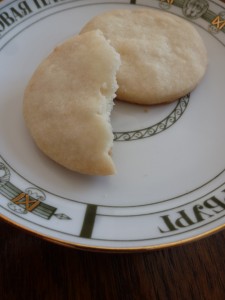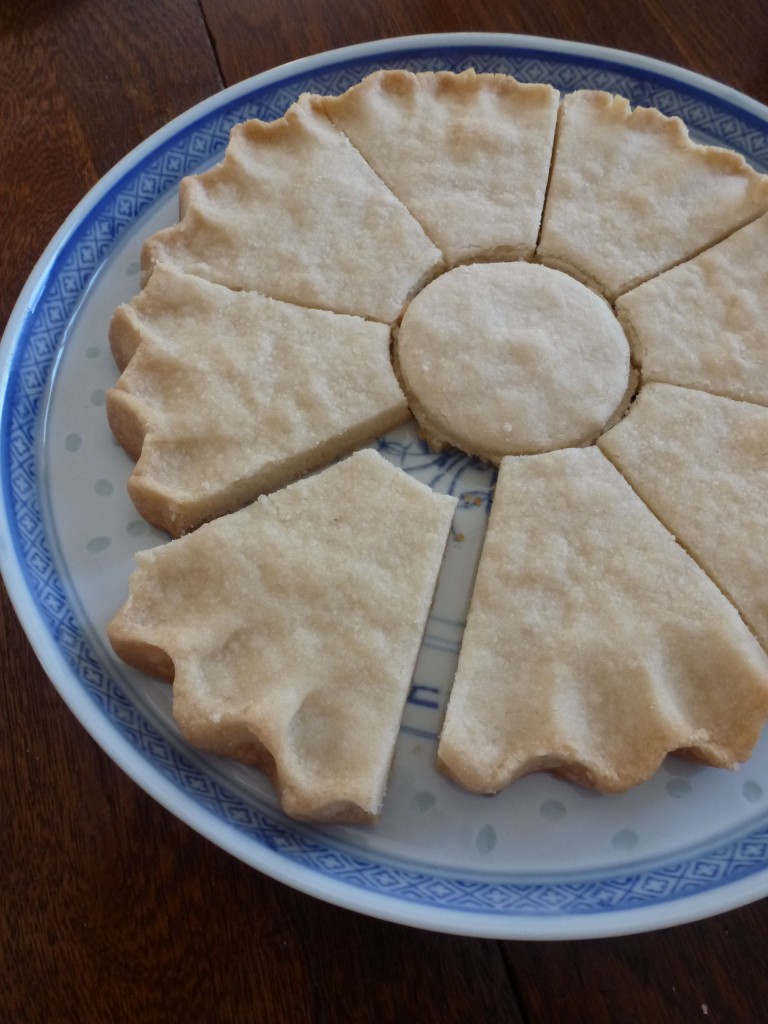Originally published December 1, 2013.
The triumph of Scottish baking on the old national lines.
-TF Henderson
 Shortbread is the primordial cookie. It has only three ingredients: sugar, butter, and flour. And I guess salt is a welcome addition. Sometimes there’s caraway. And there are a few variations like Ayrshire shortbread that include eggs and cream. But usually it’s just sugar, butter, and flour, combined in a very simple ratio: 1:2:3.
Shortbread is the primordial cookie. It has only three ingredients: sugar, butter, and flour. And I guess salt is a welcome addition. Sometimes there’s caraway. And there are a few variations like Ayrshire shortbread that include eggs and cream. But usually it’s just sugar, butter, and flour, combined in a very simple ratio: 1:2:3.
In other words, butter makes up fully one third of the weight of the dough, so this is indeed a very short dough, “short” referring to fat’s ability to inhibit gluten development, creating a tender, brittle pastry. Some classic recipes will even replace a portion of the wheat flour with rice flour or arrowroot starch, which is even lower in gluten.
The other important characteristic of classic shortbread is that the only moisture in the dough comes from the scant water-content of the butter. In fact there is so little water that not all the starch in the flour will be able to absorb moisture and gelate, which explains shortbread’s crumbly texture.
Being a dry dough that doesn’t spread during baking, shortbread is particularly well-suited to being shaped before baking. Dough made with fine sugar like caster or berry sugar spreads less during baking than that made with coarse sugar.
Traditional Shapes. Shortbread dough has to be warmer than fridge temperature to be workable. I typically leave it on the counter for an hour before rolling. There are several traditional forms.
- Shortbread is often pressed into molds. Traditional images include all manner of Scots paraphernalia: thistles, heather, clover (“trefoil”)…
- Long rectangles called fingers are common.
- The most common shapes are round discs, usually notches along the perimeter with thumb and forefinger, or with the tines of a fork. This is said to mimmic the sun’s rays, especially on Hogmanay, the Scots New Year. The shortbread rounds can be sized for individual consumption, or made larger, and cut into wedges much like a pie, in which case the cookie is called petticoat tails.[1] See the picture below.
- Shortbread doughs of all shapes are often “docked,” that is, perforated with the tines of a fork.
Baking
After shaping the cookies it’s best to hold them at fridge temperatures for at least fifteen minutes. The colder the cookies are when they go into the oven, the better they will hold their shape during baking.
Different folks have different tastes, but generally baking is done so as not to brown the cookies too much. For thinner, individual cookies I use a relatively high temperature, maybe 375°F. For thicker version like petticoat tails I bake at 325°F to give the dough a chance to cook through before the exterior turns golden brown.
Other Traditions
Like haggis, shortbread is very much a festive dish, associated particularly with Christmas and Hogmanay. In Shetland shortbread is part of a traditional wedding, where it’s called the bride’s bonn and is used in a “throwing of the girdle” type game.[2]
Shortbread
Ingredients
- 8 oz caster sugar (granulated works okay in a pinch…)
- 16 oz butter, room temperature
- 22 oz all-purpose flour, sifted
- 1 tbsp kosher salt
Procedure
- Using the paddle attachment, cream together the sugar, butter, and salt at high speed in the bowl of a stand mixer. The mixture will lighten in colour and take on a light, fluffy aspect. This should take about 6 minutes. Be sure to periodically scrape down the sides of the bowl.
- Reduce the speed of the mixer to low and add the sifted flour.
- Transfer the crumbly dough to the counter and press it together with your hands. At this point the dough can be wrapped and refrigerated or frozen. It will last for a couple weeks in the fridge.
- Remove the dough from the fridge about an hour before you intend to roll it out. It can be a little tricky getting the dough to the perfect temperature, at which it is just workable. If the dough gets too warm it is hard to work with and doesn’t shape well.
- Roll out the dough and shape as desired. Transfer cookies to a heavy bake sheet and refrigerate for 30 minutes.
- For thin, individual cookies, bake at 375°F until just turning golden brown, maybe 12 minutes, rotating the tray half way through baking. For thicker styles like petticoat tails, bake at 325°F until just turning golden brown, maybe 16 minutes.
Dark Shortbread
Many would not consider the following cookie a shortbread, as shortbread is usually virginal white, but before refined white flour and sugar were common, shortbread often contained oats, whole wheat flour, and other “less refined” ingredients. This is an original recipe I adapted from the shortbread recipe in the Culinary Institute of America’s Baking and Pastry, Second Edition.
Ingredients
- 8 oz cake flour
- 8 oz whole wheat flour
- pinch of salt
- 11 oz butter
- 5 oz white sugar
- 8 oz brown sugar
Procedure
- As for classic shortbread, above.
Notes and References
- Being a young man in the twenty-first century, I had to look up what a “petticoat” is. Though apparently an archaic garment associated with European court fashion, a Google image search turned up some very racy pictures which did a good job of explaining the term to me. A petticoat is an undergarment, usually in the form of a ruffled, voluminous skirt, worn under a gown or dress, meant to keep the woman warm and give body and shape to the gown or dress worn over top. The bottom of the petticoat is usually exposed. Along with corsets, it is also part of a classic cabaret get-up.
- McNeill, F. Marian. The Scots Kitchen. ©2010 The Estate of F. Marian McNeill. Birlinn Ltd, Edinburgh, Scotland. Page 242. This is also where I learned about the different recipes and shapes, like Ayrshire shortbread and petticoat tails. I love this book. Thank you, Lizzie!
